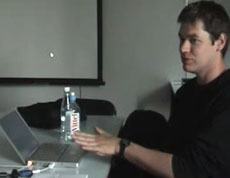« Existing mishmash situations' analysis (workshop Ben Hooker) | Main | Ben Hooker - Dataclimates - Royal College of Art, London »
15. 05. 2006 15:25 | 04_Workshop_2 , 12_Curated_posts
"Designing for mishmash" workshop
Ar&D and 3rd year MID students Workshop with Ben Hooker
Monday 8th to Friday 12th May 2006

Works & Projects presentation
ecal 08.05.2006 (1h00 vidéo flash8)
Works & Projects at the Royal College of Art
ecal 10.05.2006 (1h00 vidéo flash8)
-
New information and communications technologies and the services they
enable often evoke feelings of escape from the messy, constrained, physical, world we inhabit. For example, advertisers of 'virtual' Internet-based products frequently show images of people undertaking unambiguous tasks, blissfully disconnected from any distractive physical environment, or, if they are portrayed in a real context it is a simplistic one – writing an email in an office, phoning a friend from a car, shopping on the Internet while at home. These aspirational characters seem have everything under control and they can do everything they need to from their desktop, laptop or mobile phone.
-
Obviously – and thankfully – this is only part of the picture of the
Information age. Information and communication technologies cannot
diminish the importance of the physical world – but they can and do cause it to fragment and shift around a bit. For example, consider the Internet-based bookseller Amazon. We perhaps think of Amazon as a 'virtual' bookstore, but on the outskirts of London, in a massive new distribution depot there is intense physical activity as the depot processes orders in response to people buying books on the website. There are many other examples of similar situations. It's clear that the day-to-day physical places we inhabit are becoming *more* complicated, not less, because of all the building work in cyberspace.
-
This project is not just about the link between Internet spaces and physical spaces. The aim of the workshop is to uncover and explore the design potential of new situations that are occurring as the result of information and communication technologies being woven ever more intricately into our day-to-day lives.
-
Part 1
Collect examples of 'mishmash' situations involving technology which
contrast to the bland, homogeneous scenarios fed to us by advertisers.
These can be real situations that you have researched or observed directly or can be entirely speculative, so long as they are grounded in fact. They can be localised or large-scale, e.g. What *really* happens when you try to do 3-4 things together like phoning and computing and buying and walking?
-
Part 2
Design an 'interface' prototype inspired by your chosen situation. This 'interface' could be anything which provides a new level of access to the situation you have uncovered. It could be a spatial or architectural intervention, a device, an object or piece of software which provides a very specific service.
-
The idea is not to build a working object, but to present an intellectually challenging design proposal by using a combination of a basic prototype or prop (using card, film, animation, sketches...) together with a narrative which enlightens the audience about how the object would be used and what new situations could be created as a consequence of its use. Use your design proposal to take social and political risks. Push the limits of peoples' imaginations. Your proposal can be as fantastical as you desire so long as you can explain how it could work and how it's usage could 'fit' into the
reality of life today.
-
Download the brief (PDF)
Posted by aude at 15. 05. 2006 15:25